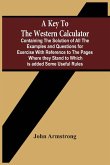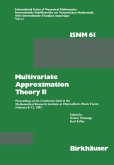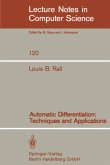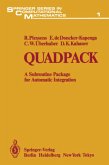Josef Dick, Peter Kritzer, Friedrich Pillichshammer
Lattice Rules
Numerical Integration, Approximation, and Discrepancy
Josef Dick, Peter Kritzer, Friedrich Pillichshammer
Lattice Rules
Numerical Integration, Approximation, and Discrepancy
- Gebundenes Buch
- Merkliste
- Auf die Merkliste
- Bewerten Bewerten
- Teilen
- Produkt teilen
- Produkterinnerung
- Produkterinnerung
Lattice rules are a powerful and popular form of quasi-Monte Carlo rules based on multidimensional integration lattices. This book provides a comprehensive treatment of the subject with detailed explanations of the basic concepts and the current methods used in research. This comprises, for example, error analysis in reproducing kernel Hilbert spaces, fast component-by-component constructions, the curse of dimensionality and tractability, weighted integration and approximation problems, and applications of lattice rules.
Andere Kunden interessierten sich auch für
![Lattice Rules Lattice Rules]() Josef DickLattice Rules116,99 €
Josef DickLattice Rules116,99 €![Rules For The Mental Calculator Rules For The Mental Calculator]() Frederick J. EdwardsRules For The Mental Calculator23,99 €
Frederick J. EdwardsRules For The Mental Calculator23,99 €![Graded Exercises in the Simple Rules of Arithmetic for First and Second Classes of the Public Schools of Ontario [microform] Graded Exercises in the Simple Rules of Arithmetic for First and Second Classes of the Public Schools of Ontario [microform]]() George MoirGraded Exercises in the Simple Rules of Arithmetic for First and Second Classes of the Public Schools of Ontario [microform]33,99 €
George MoirGraded Exercises in the Simple Rules of Arithmetic for First and Second Classes of the Public Schools of Ontario [microform]33,99 €![A Key To The Western Calculator; Containing The Solution Of All The Examples And Questions For Exercise With Reference To The Pages Where They Stand To Which Is Added Some Useful Rules A Key To The Western Calculator; Containing The Solution Of All The Examples And Questions For Exercise With Reference To The Pages Where They Stand To Which Is Added Some Useful Rules]() John ArmstrongA Key To The Western Calculator; Containing The Solution Of All The Examples And Questions For Exercise With Reference To The Pages Where They Stand To Which Is Added Some Useful Rules20,99 €
John ArmstrongA Key To The Western Calculator; Containing The Solution Of All The Examples And Questions For Exercise With Reference To The Pages Where They Stand To Which Is Added Some Useful Rules20,99 €![Multivariate Approximation Theory II Multivariate Approximation Theory II]() SchemppMultivariate Approximation Theory II41,99 €
SchemppMultivariate Approximation Theory II41,99 €![Automatic Differentiation Automatic Differentiation]() L. B. RallAutomatic Differentiation29,99 €
L. B. RallAutomatic Differentiation29,99 €![Quadpack Quadpack]() R. PiessensQuadpack97,99 €
R. PiessensQuadpack97,99 €-
-
-
Lattice rules are a powerful and popular form of quasi-Monte Carlo rules based on multidimensional integration lattices. This book provides a comprehensive treatment of the subject with detailed explanations of the basic concepts and the current methods used in research. This comprises, for example, error analysis in reproducing kernel Hilbert spaces, fast component-by-component constructions, the curse of dimensionality and tractability, weighted integration and approximation problems, and applications of lattice rules.
Produktdetails
- Produktdetails
- Springer Series in Computational Mathematics 58
- Verlag: Springer / Springer International Publishing / Springer, Berlin
- Artikelnr. des Verlages: 978-3-031-09950-2
- 1st edition 2022
- Seitenzahl: 596
- Erscheinungstermin: 24. Juli 2022
- Englisch
- Abmessung: 241mm x 160mm x 38mm
- Gewicht: 1051g
- ISBN-13: 9783031099502
- ISBN-10: 3031099508
- Artikelnr.: 64122816
- Herstellerkennzeichnung Die Herstellerinformationen sind derzeit nicht verfügbar.
- Springer Series in Computational Mathematics 58
- Verlag: Springer / Springer International Publishing / Springer, Berlin
- Artikelnr. des Verlages: 978-3-031-09950-2
- 1st edition 2022
- Seitenzahl: 596
- Erscheinungstermin: 24. Juli 2022
- Englisch
- Abmessung: 241mm x 160mm x 38mm
- Gewicht: 1051g
- ISBN-13: 9783031099502
- ISBN-10: 3031099508
- Artikelnr.: 64122816
- Herstellerkennzeichnung Die Herstellerinformationen sind derzeit nicht verfügbar.
Josef Dick is a Professor in the School of Mathematics and Statistics at the University of New South Wales in Sydney, Australia. His research focuses on computational mathematics and its applications, in particular, quasi-Monte Carlo methods for integration and approximation, and its applications to Uncertainty Quantification. He works in the area of computational mathematics, in particular quasi-Monte Carlo methods and Uncertainty Quantification. He has been awarded several prices, including the Heyde Medal of the Australian Academy of Science and the Medal of the Australian Mathematical Society. He is a member of the steering committee of the conference series on Monte Carlo and quasi-Monte Carlo methods (MCQMC), a senior Editor of the Journal of Complexity, and an Editor of the Journal of Approximation Theory. Peter Kritzer is a Senior Scientist at the Johann Radon Institute for Computational and Applied Mathematics (RICAM) of the Austrian Academy of Sciencesin Linz, Austria, where he leads a work group doing research on quasi-Monte Carlo methods, multivariate algorithms, and Information-Based Complexity. Peter Kritzer's research focuses on mostly theoretical aspects of high-dimensional numerical integration, function approximation, and Information-Based Complexity. He has worked at Austrian and Australian universities and research institutions and has been awarded several prizes, such as the Information-Based Complexity Young Researcher Award, the Prize for Achievements in Information-Based Complexity, and the Christian Doppler Award. Apart from his research work at the Austrian Academy of Sciences, he teaches at Johannes Kepler University Linz and serves as an editorial board member of the Journal of Complexity. Friedrich Pillichshammer is an Associate Professor in the Institute for Financial Mathematics and Applied Number Theory at the Johannes Kepler University Linz, Austria. He is an author with Josef Dick of the book"Digital Nets and Sequences - Discrepancy Theory and Quasi-Monte Carlo Methods" and with Gunther Leobacher of the book "Introduction to Quasi-Monte Carlo Integration and Applications". Friedrich Pillichshammer's work is devoted to the theory and foundations of quasi-Monte Carlo methods. This comprises his research work but also teaching experience. For his work he received several honors. Examples are the Information-Based-Complexity award, a best paper award from the Journal of Complexity and awards from the Austrian Mathematical Society and from the Austrian Academy of Sciences. He is member of scientific committees and editorial boards like the steering committee of the MCQMC conference series, the editorial board of the Journal of Complexity and Managing Editor of the journal Uniform Distribution theory.
Introduction.- Integration of Smooth Periodic Functions.- Constructions of Lattice Rules.- Modified Construction Schemes.- Discrepancy of Lattice Point Sets.- Extensible Lattice Point Sets.- Lattice Rules for Nonperiodic Integrands.- Intrgration with Respect to Probability Measures.- Integration of Analytic Functions.- Korobov's p-Sets.- Lattice Rules in the Randomized Setting.- Stability of Lattice Rules.- L2-Approximation Using Lattice Rules.- L -Approximation Using Lattice Rules.- Multiple Rank-1 Lattice Point Sets.- Fast QMC Matrix-Vector Multiplication.- Partial Diffeential Equations With Random Coefficients.- Numerical Experiments for Lattice Rule Construction Algorithms.- References.- Index.
Introduction.- Integration of Smooth Periodic Functions.- Constructions of Lattice Rules.- Modified Construction Schemes.- Discrepancy of Lattice Point Sets.- Extensible Lattice Point Sets.- Lattice Rules for Nonperiodic Integrands.- Intrgration with Respect to Probability Measures.- Integration of Analytic Functions.- Korobov's p-Sets.- Lattice Rules in the Randomized Setting.- Stability of Lattice Rules.- L2-Approximation Using Lattice Rules.- L -Approximation Using Lattice Rules.- Multiple Rank-1 Lattice Point Sets.- Fast QMC Matrix-Vector Multiplication.- Partial Diffeential Equations With Random Coefficients.- Numerical Experiments for Lattice Rule Construction Algorithms.- References.- Index.

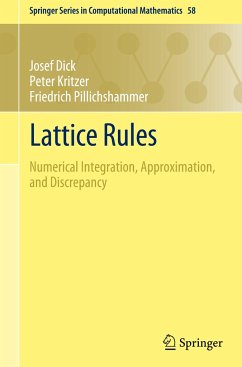
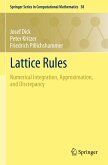
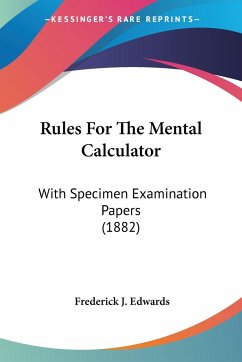
![Graded Exercises in the Simple Rules of Arithmetic for First and Second Classes of the Public Schools of Ontario [microform] Graded Exercises in the Simple Rules of Arithmetic for First and Second Classes of the Public Schools of Ontario [microform]](https://bilder.buecher.de/produkte/65/65533/65533366m.jpg)
